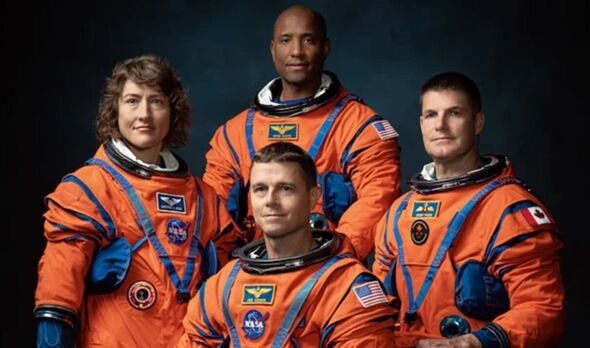Science
NASA Selects New Astronauts for Historic Moon Mission

NASA has announced the selection of ten new astronauts who will play pivotal roles in humanity’s return to the Moon under the Artemis program. This decision follows an extensive search, with over 8,000 applicants vying for a chance to participate in what could be the first crewed lunar mission in 50 years. The announcement marks a significant milestone, as this is the first astronaut class in history to include more women than men, reflecting a commitment to greater diversity in space exploration.
A New Era in Space Exploration
The newly selected astronauts are part of the 24th astronaut class since the Mercury Seven in 1959. Their backgrounds encompass a diverse range of expertise, significantly enhancing the capabilities of the Artemis program. One astronaut, a geologist who contributed to NASA’s Curiosity Mars rover, brings invaluable knowledge about planetary surfaces, which is critical for both lunar and Martian missions. Another addition is a SpaceX engineer who participated in a groundbreaking private spaceflight, achieving the world’s first private spacewalk. This inclusion emphasizes the growing role of commercial ventures in space exploration, particularly as NASA collaborates with companies like SpaceX.
The Apollo missions, which took place from 1961 to 1972, set a high bar for human achievement in space. The historic landing of Apollo 11 in 1969 saw astronauts Neil Armstrong and Buzz Aldrin become the first humans to walk on the lunar surface. Armstrong’s iconic words, “That’s one small step for man, one giant leap for mankind,” resonate throughout history. Over six Apollo missions, 12 astronauts explored the Moon, gathering samples and conducting experiments that expanded our understanding of the cosmos. The last crewed lunar mission, Apollo 17, took place in 1972, after which NASA redirected its focus to low-Earth orbit projects such as the Space Shuttle and the International Space Station.
The Future of Lunar Exploration
The Artemis program aims to reignite lunar exploration with ambitious goals, including landing the first woman and the first black person on the Moon. This initiative intends to establish a sustainable lunar presence, serving as a precursor to future missions to Mars. The astronauts will undergo intensive training at NASA’s Johnson Space Center in Houston, mastering essential skills such as spacewalking, operating the Orion spacecraft, and adapting to harsh environments. Upon completion of their training, they will join the ranks of 41 active U.S. astronauts, becoming eligible for Artemis missions that could see them walking on the Moon within months.
Acting NASA Administrator Sean Duffy has suggested that some of these astronauts may even become the first humans to set foot on Mars. This vision aligns with the broader ambitions of the space community, particularly those of Elon Musk, who envisions establishing a self-sustaining city on Mars by 2050, supported by SpaceX’s Starship, a reusable rocket designed for human and cargo transport to the Red Planet.
While NASA’s timeline focuses on lunar missions throughout the 2020s, with aspirations for Mars in the 2030s or 2040s, partnerships with commercial entities like SpaceX highlight a shared goal of making humanity multi-planetary.
The selection process for NASA’s astronaut corps has always been highly competitive, with only 370 individuals selected in the program’s 66-year history. The latest class represents a shift in demographics, showcasing both gender balance and exceptional talent. Flight Operations Director Norm Knight praised the new astronauts as “distinguished” and “exceptional,” underscoring the rigorous selection process they underwent.
The Artemis program builds on the legacy of the Apollo missions, aiming to create a lunar gateway and surface habitats that will enable longer stays and facilitate scientific research. This infrastructure is crucial for testing technologies needed for Mars, where challenges such as radiation exposure, vast distances, and limited resources will necessitate innovative solutions.
As Artemis approaches its first crewed lunar landing, the newly selected astronaut class embodies the hope for a revitalized era of exploration. Their future contributions could redefine humanity’s place in the cosmos, bridging the historic triumphs of Apollo with a future in which Mars becomes a second home for humankind.
-

 Health2 months ago
Health2 months agoNeurologist Warns Excessive Use of Supplements Can Harm Brain
-

 Health3 months ago
Health3 months agoFiona Phillips’ Husband Shares Heartfelt Update on Her Alzheimer’s Journey
-

 Science4 weeks ago
Science4 weeks agoBrian Cox Addresses Claims of Alien Probe in 3I/ATLAS Discovery
-

 Science4 weeks ago
Science4 weeks agoNASA Investigates Unusual Comet 3I/ATLAS; New Findings Emerge
-

 Science3 weeks ago
Science3 weeks agoScientists Examine 3I/ATLAS: Alien Artifact or Cosmic Oddity?
-

 Science3 weeks ago
Science3 weeks agoNASA Investigates Speedy Object 3I/ATLAS, Sparking Speculation
-

 Entertainment4 months ago
Entertainment4 months agoKerry Katona Discusses Future Baby Plans and Brian McFadden’s Wedding
-

 World2 months ago
World2 months agoCole Palmer’s Cryptic Message to Kobbie Mainoo Following Loan Talks
-

 Entertainment4 months ago
Entertainment4 months agoEmmerdale Faces Tension as Dylan and April’s Lives Hang in the Balance
-

 Science3 weeks ago
Science3 weeks agoNASA Scientists Explore Origins of 3I/ATLAS, a Fast-Moving Visitor
-

 Entertainment4 months ago
Entertainment4 months agoLove Island Star Toni Laite’s Mother Expresses Disappointment Over Coupling Decision
-

 Entertainment3 months ago
Entertainment3 months agoMajor Cast Changes at Coronation Street: Exits and Returns in 2025









